Luxury camping has become hugely popular in Georgia over the past year or so, with numerous glamping resorts popping up in different mountain regions around the country.
While many market themselves as the perfect selfie spot, Glamping Tago is a bit different: Here in the highlands of Adjara, the focus is on mindful travel and cultivating meaningful connections – with the landscape, with other guests, and most importantly with the local people and their cultures.

I couldn’t imagine a better setting for a ‘social glamping’ experiment than remote Tago village east of Batumi. Located on the opposite side of the valley from Khulo and reached via the Khulo Cable Car – the second-longest free span cable car in Europe – it’s quite an entrance, and quite a location.
Part-way through their first season, I was invited to visit Glamping Tago and experience it for myself.
A big thank-you to Jonas and the team for hosting us for two nights in exchange for this honest review. As always, all opinions, recommendations and criticisms are 100% my own.
Please note: This post contains affiliate links, meaning I may earn a commission if you make a purchase by clicking a link (at no extra cost to you). Learn more.

Glamping Tago: The basics
Location: Tago village, Upper Adjara (~3 hours from Batumi via Khulo)
Accommodation: 7 Lotus Belle tents (each tent sleeps up to 3 adults)
Best time to go: June-October (no bookings over the winter season)
Price: From 75 GEL
Other services: Meals, bar, WIFI, transfers to/from Khulo
Reservations: Visit the Glamping Tago website
The Glamping Tago story
It’s a familiar narrative: Tourist travels around Georgia; falls in love; and on a whim decides to put down roots. You’d be surprised how many hotels and tour companies start out this way. Georgia tends to have that effect on people.
Glamping Tago’s origin story is much the same. Founder Jonas Shaik is originally from Belgium. He was hitchhiking around Georgia when he found himself in Tago village. The location stole his heart, and after three nights staying in the village, he impulsively forked out a deposit for a piece of land. Not just any old piece of land: A pristine sliver of ridge with the best views on this side of the valley.
That was almost five years ago. Travelling back and forth to Adjara, working a remote job and pursuing investors, Jonas slowly brought his vision for Glamping Tago to life. He did almost all the work himself, piece by piece, tent by tent.
In summer 2021, he was finally ready to share his creation with the outside world.

‘Social glamping’ concept
Jonas’ project underwent many iterations in the development phase (at one point it was going to be a hostel), but the main goal has always remained constant: Create a place where people can both escape and connect.
As you sail over the valley into Tago village on the famous Khulo Cable Car, you do get the feeling you’re leaving the real world behind. Tago is remote enough to feel detached, but still convenient to get to for a long weekend or short break.
The way the glamping complex is laid out with multiple common areas, it’s impossible not to interact with the other guests. With only seven tents, it’s never too crowded though.
Meals are eaten together (you can sit separately if you want), and a campfire draws everyone in like moths to the flame in the evenings. The laid back vibe here is similar to the wonderful Karma Hostel in Martvili, but you can still find privacy when you need it by retreating to your tent – your own little bubble.

One thing you definitely can’t escape is the landscape: Whichever way you look, you’re met with absolutely epic mountain views. Because of the way the campsite is laid out, each tent has its own panoramic vista. Zip up your door flap and open the window overlooking the valley, and you instantly feel lost in the hills.
Jonas wants his glamping retreat to be for tourists, expats and locals alike, and we certainly encountered a diverse mix of people during our stay. In the future, he plans to host workshops and events that showcase local culture and creativity.

Responsible tourism
Being so secluded and such a peaceful, traditional community, you can’t help but wonder how Glamping Tago has been received by the locals.
If residents wanted to keep Tago to themselves, I wouldn’t blame them one bit. But this hasn’t been the attitude: As Jonas explains, 99% of people have warmly embraced the project.
This might be the first large-scale accommodation in the village (before Glamping Tago, there were one or two family guesthouses), but this village is no stranger to tourism. Many people visit Khulo just to ride the cable car.

In the early days, Jonas consulted with each family in Tago and found that most people were excited at the idea of developing tourism. He’s making real efforts to make sure everyone benefits in some way: Staff and drivers are all local, and fresh produce is sourced from farmers in the village.
Speaking to Jonas, it’s obvious he has a deep respect for this part of Georgia. Remember he chose the location first before settling on the glamping concept. He wanted to build something here in this place that resonated with him – not the other way around.
On the website, you’ll find a beautiful series of stories about Tago, Khulo and the history of the cable car. Jonas is thinking about expanding to new locations in the future, but I get the feeling his heart will always be here in Tago.

The tents
Social interaction, responsible tourism and community engagement are all strong values underpinning Glamping Tago. In the same vein, the idea of not wanting to be a blight on the environment – of wanting to fit in and show respect for the mountains – has influenced Jonas’ design decisions.
The biggest difference between Glamping Tago and other camps like it in Georgia is the tents. Jonas settled on Lotus Belle tents because they have a more organic shape than the popular transparent ‘bubble pods’ you see elsewhere.
Made from cotton canvas and mounted on timber poles, they look right at home in the mountains.

I was surprised by just how spacious they feel inside: There’s more than enough room to unpack and get comfortable (and of course the tents are tall enough so that you can stand fully upright).
Each one is 12 square-metres and big enough to accommodate a double mattress, a sitting chair, a side table, and a lamp. Carpet floors and the addition of a rug makes the space extra cosy. Each tent has two four-socket power boards for recharging your devices.

Now is a good time to mention that Glamping Tago is kid-friendly. Each tent can sleep up to three adults or a couple and two kids.
There are two categories of tent to choose from: The Sunset View Tent and the Mountain View Tent. Both offer jaw-dropping glimpses of either side of the valley, so I wouldn’t be too concerned about which one you pick. We stayed in both – I did slightly prefer the view from the Mountain Tent, which overlooks the rooftops of Tago in the distance.

Sleeping in a tent, you feel more connected to the landscape and exposed to the elements. On our second night, a huge storm rolled through – it was so nice to listen to the rain.
On a clear night, you might hear dogs in the village and jackals in the mountains barking and howling. It can get a bit noisy, so earplugs are provided.
Update: In 2022, Glamping Tago added fireplaces to the tents and a fire pit outside, making it possible to stay later into the chilly autumn season. They also have a new geodesic dome!

Bathrooms
At the top of the ridge Jonas has built a generous wooden cabin to house three showers, toilets, and a set of open-air washbasins that look out over the valley. This has to be the best place in Georgia to brush your teeth.
The design of the bathrooms is every bit as thoughtful as the tents. I especially love the use of natural wood. The corner shower has a big window and definitely the best views (thanks to Jonas for pointing that out during our tour!).


Food & drink
Glamping Tago provides breakfast and dinner on request (plus a packed lunch service if you need it). Meals are served help-yourself-buffet-style in the kitchen, which is located inside a cosy Mongolian yurt.
Food is vegetarian and thanks to the small team of chefs, extremely delicious. We had pizza, lasagne, a local bean dish, grilled veggies, rosemary potatoes and banana bread for dessert.

Dinner includes a drink. Inside the yurt, there’s a small bar with beer on tap, and the wine comes courtesy of local producers in Keda. You can help yourself to tea, coffee and fresh spring water at any time.
There are several dining tables inside the yurt so you can sit with other guests or separately if you prefer. On our second morning, we decided to take our breakfast outside and eat overlooking the valley.

Activities & things to do
You can easily fill your days at Glamping Tago just relaxing in your tent or sitting in the yurt. If you need to work, there is WIFI. Despite being in the mountains, my Magti connection worked perfectly.
One activity I do recommend is taking a short walk around Tago. It’s a very small, bucolic village of timber houses, with picturesque wood piles, retro cars, a couple of house museums, and a small mosque (this is Adjara where many rural areas are predominantly Islamic).
The call to prayer is clearly audible from the campsite – hearing it ring out across the valley every morning and evening is one of my favourite memories from our stay.

If you want to grab a coffee or a bite to eat during the day, there is a small local restaurant in Tago called Cafe Toma. It’s right next to the cable car station.

The Khulo Cable Car is of course an attraction in itself and something you should try at least once while you’re here. Built in 1985, it’s the second-longest free span cable car in Europe.
It stretches for almost two kilometres over the valley, 350 metres above the treetops.

The ride lasts for around nine minutes – which is a very long time when you think about it! I was a bit nervous about the ride (my fears were not really allayed when I stepped into the cabin and saw how much sticky tape was being used to secure bits and pieces), but I had to remind myself that people use this service every day for getting to work and running errands.
The first couple of cars of the day (between 9am and 10am) are usually full, so it’s best to ride the cable car in the mid-morning.


The cable car is free for locals, but tourists are kindly asked to pay a small fee of 5 GEL for a return trip (paid on your way up). It is possible to negotiate the price but there’s really no point – the money is used for maintenance, so just think of it as a donation to keep this vital lifeline running.

On the other side of the ropeway in Khulo, you’ll find a mosque, a museum and several restaurants.
If you’re into hiking, there are a couple of marked trails around Tago, including the one to Skhalta Monastery, the only medieval church in the region that survived both Ottoman and Soviet rule.
How to get to Glamping Tago
Tago village can be reached from Khulo, the main town in Upper Adjara. There are two ways to get to Khulo: Driving east from Batumi (2.5-3 hours via a good quality, fully asphalted road) or driving west from Akhaltsikhe (4-5 hours via a partially unfinished road).
The latter is only recommended if you have a car with high clearance. The mountain pass may be closed off in winter, but the road from Batumi remains open throughout the year.
- Also see: How to get to Batumi from Kutaisi
- Also see: How to get to Batumi from Tbilisi
Marshrutka vans depart from Batumi’s old bus station every 30 minutes from 8am. The fare to Khulo is 7 GEL.
From Khulo, you have two options for getting to and from Tago.
Option 1: Khulo cable car
The fastest and easiest way to get to Tago from Khulo is using the cable car. It takes less than 10 minutes to cross the valley, followed by a 15-20 minute walk up to the tents.
The lower cable car station is located in the middle of town. Normal working hours are from 9am to 6pm, with a lunch break from 1pm-2pm. There is no schedule; cars depart on demand and you might have to wait for more people to join you. The fare is 5 GEL for a return trip.
Note: If there is strong wind or scheduled maintenance works, the cable car might not be running (either for the whole day or just for a short period). If you have any concerns, check with Glamping Tago before you arrive – staff are in contact with the operator. Or you can ask at the tourist information office in Khulo, located right next to the cable car station.
When you arrive in Tago, you will immediately see the glamping site directly above you. It takes around 15-20 minutes to walk the rest of the way.
As you exit the cable car, take the path on the right near the yellow tourist information sign – this will lead you right up to the tents. The dirt track crisscrosses corn fields and takes you through several farm gates. It’s steep in some sections, but easy to manage as long as you don’t have too much luggage.

Option 2: Taxi to Glamping Tago
If the cable car isn’t running or you just prefer to keep your feet on the ground, it’s easy to find a driver to take you to or from Tago. I recommend organising this through Glamping Tago ahead of time. We decided to take a taxi back to Khulo on our last morning.
The journey by road takes around 30-40 minutes and costs 40 GEL per car.
The dirt road is very rough – especially the last part through Tago – so I’d only recommend tackling it yourself if you have a 4WD and a decent amount of off-roading experience. It’s not advisable to drive after heavy rain as the whole road turns to slush.
Leaving your car in Khulo
If you’re driving yourself, you’ll need to park your car in Khulo before continuing to Tago. Generally speaking it’s perfectly safe to leave your car unattended overnight in Georgia, especially in a small town like Khulo. I recommend finding a quiet spot somewhere up the hill.
We left our rental on the main road in what we thought was the perfect location – but after receiving multiple calls from local police at midnight, we had to go back to Khulo the next morning and move it. (It was sheer bad luck, we had accidentally parked right where an event was being set up – of course there were no signs!)
If in doubt, knock on the nearest door and ask the homeowner if it’s OK to leave your car out front (this is what we did the second time around).

Other tips for visiting Glamping Tago
- Pack light. There’s a bit of walking involved to get to the campsite so you don’t want to be burdened with heavy luggage.
- Don’t bother bringing shampoo or body wash. Unless your products are biodegradable, Glamping Tago asks you to use theirs.
- Bring a jacket or scarf. It can get chilly in the evenings, even in summer.
- Bring bug spray. I didn’t see any mosquitoes in Tago, but I did get a few bites on the way up to Khulo. The tents have insect nets.
- BYO tent? If you’re into camping rather than glamping, there is a space to pitch your own tent at the end of the ridge.
You might also be interested in…
- The ultimate Georgia itinerary: Four detailed & custom-designed itineraries
- Georgia Travel Guide: All of my 200+ posts plus my top travel tips
- Georgia travel tips: 25 essential things to know before you go
- Places to visit in Georgia: 50+ unique & underrated destinations around the country
- The best things to do in Tbilisi: Favourites, hidden gems & local picks
- 35+ best restaurants in Tbilisi: Where to eat Georgian food
- 15 best day trips from Tbilisi: With detailed transport instructions
- The best time to visit Georgia: Month-by-month guide to weather, festivals & events